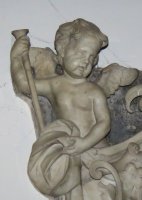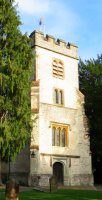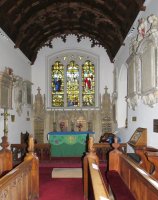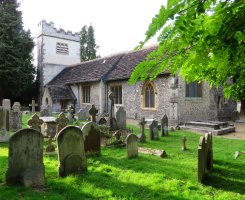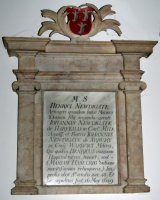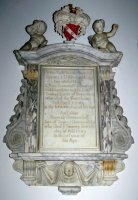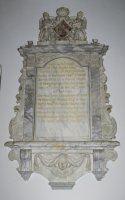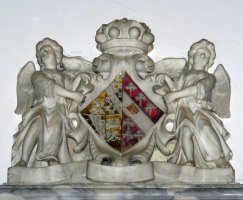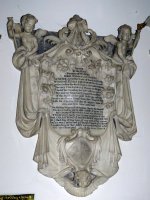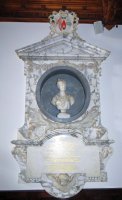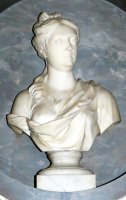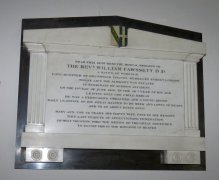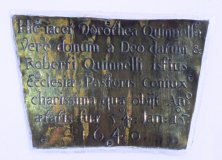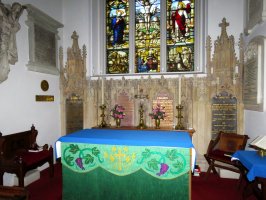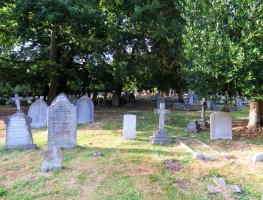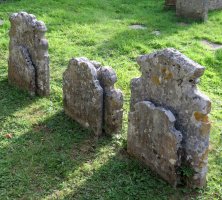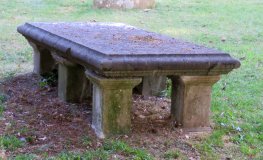Ashtead Church monuments
St Giles Church, Ashtead, a couple of miles from Epsom, contains half a dozen larger sized panel monuments with carving from the late 17th and 18th Centuries, including an example each by the famous woodcarver Grinling Gibbons and by the sculptor William Stanton, along with a few plainer and a few later monuments. Click any picture to enlarge, or hover for caption.
Ashtead Church monuments.
The Church of St Giles, Ashtead is a low building, broad for its height, with nave and single aisle, porch, and a short, buttressed square tower with a Newell (corner) tower. All faced in flint with pale stone dressings, more orangey sandstone around some of the windows. It is largely of 15th and 16th Century date, including the 16th century tower, however the nave was commenced in the 12th Century, including reusing a few Roman bricks in the wall, and the chancel having some older work likely from the 13th Century. The 19th Century saw major remodelling of the interior, most especially the roofing, and some work on the exterior, including some of the tower windows.
Ashtead Church from the churchyard.
Inside, the monuments are dotted around the walls, with the larger ones near the reredos, as seen in the picture at the top of the page (click to enlarge). We take them in date order.
Monuments
Henry Newdigate, d.1629, with a Latin inscription. The heavy surround includes set forward Ionic pilasters to the sides, supporting an oversized entablature. On top sits a painted shield of arms surrounded by carved leafy branches; there may have been more to the sides, and, perhaps the arms would have been raised up and within a pediment. There would have been something below the base too. This monument hardly shrieks early 17th Century to the viewer, and it is in fact a minor work of Grinling Gibbons no less, dating from 1693; the same year that Lady Newdigate died, with Gibbons' monument to her being in Harefield Church along with a prodigious number of other Newdigates.
William Duncumb, d.1698, and his wife Philadelophia, d.1724; he was a rector of the Church. The central panel has Ionic side pilasters, with entablature and shelf above, which presumably once bore something on top. A further shelf at the base.
Thomas Howard, Sr. & Jr.
Thomas Howard, d.1701, and his son Thomas Howard Junior, d.1702. Grand monochrome panel with lots of carving, all in pale marble with varying degrees of black streakiness. There is outer scrolling with carved descending flowers, and at the top, an arched, open pediment within which are crossed branches carved in low relief. On this sits a pair of grieving putti, with painted arms between, with much carved mantling. Under the panel, a shelf with receding sides, borne on curly brackets with a winged cherub head on the apron between, with drapery over his head and hanging to the sides before being caught up on small knots. A piece characteristic of a type popular in the earlier 18th Century. The sculptor was the eminent William Stanton.
Lady Dudley & Ward.
Diana [Howard] Lady Dudley & Ward, d.1709 – her husband was the Rt. Hon. Edward, Baron Dudley & Baron Ward of Bermingham [Birmingham]. She was daughter of Thomas Howard, whose monument is noted above, and his wife the Lady Diana Howard, who erected the monument, which is similar in type, and has equivalent scrolling to the sides, and base with cherub head under drapery. But the panel has a curved top, allowing for spandrels with carved flowers beneath a shelf on which rests the painted arms, here with crown and supporting figures of angels. To the sides are the bases of lost accoutrements, maybe obelisks or small urns.
Sarah Bond.
Sarah Bond, d.1712, erected by Richard Asshe, who married her daughter, Frances Bond, d.1710. A cartouche, with gently domed central panel surrounded by carved flowers and gracefully hanging drapes. These descend from a knot at the top, hang festoonlike to the sides, where they are held by winged cherubs, looped round and falling down, caught up again on some hidden pegs, then hanging again with drop folds to an open cloth on which is a smaller cartouche of arms above a terminus carved as a winged cherub head. Excellent, assured carving and composition. The overall shape would be roughly hexagonal, were it not for the height of the cherubs to the sides: it is more usual to have winged cherub heads, which would be lower down. They carry in their hands – those not clutching the drapery - tall tapers, one of which retains its flame.
Diana Feilding, with portrait bust.
Diana Feilding, d.1733, centred on a well-carved bust of her within a roundel. She wears a Classical robe across her chest and one shoulder, a lighter garment underneath, and her face has a Classical calmness and neck, but her plump face with a bit of a double chin and her hairstyle are of her own time. The round niche in which the bust is placed is in a dark grey marble for contrast, and all around is pale: a brecciated white and beige marble square with a festoon of flowers above and crossed branches below; an empty pediment on top with a Carrara-type marble, and the painted shield of arms on top of that. The inscription, gilt now, is underneath, under a shelf with rounded top, and to the sides are carved flowers, and at the very base a grave winged cherub head.
Revd. Thomas Denton, d.1777. Shaped as a casket end, thus with outward slanting sides to the inscribed panel, and a 'lid' bearing low relief carving of cross, books, some platter of grapes or something, and a chalice with the IHS [Jesus] sigil upon it. Acroteria ('ears') to the sides, and feet carved with acanthus leaves below. This neat piece is signed by Joseph Lockwood of Doncaster, most of whose work, unsurprisingly, is found in churches further north. See picture below left.
Lieut. General John Chester, d.1779, and wife Sophia Elizabeth Chester, d.1879. Plain white panel on dark backing panel.
Frances Howard, d.1818, her husband Richard Howard, d.1818, and their infant sons Henry and Henry Richard. Rather plain and blocky, with a sunburst above the inscription but no other carved ornament.
Revds. Denton and Fawssett (hover for captions).
The Revd William Fawssett, d.1831, Minister of Brunswick Chapel, Berkeley Street, London, 'whose life the almighty was pleased to terminate by sudden accident'. White-on-black tomb chest end, with thick upper 'lid', bearing a painted shield of arms, feet with roundels below, and receding fluted pilasters to the sides. Picture above right. On a shaped black panel, signed by Hopper of London. Humphrey Hopper has a good number of smaller monuments dotted around London and the environs - more about him on this page.
Anne Chester, d.1841, and sister Elizabeth Chester, d.1851, plain white panel, though the base suggests that it once had a surround of some sort.
Fulk-Greville Howard, d.1846, and his wife Mary Howard, d.1877. White panel with generous helping of cut flowers carved at the top, good work, on a white backing panel with curved top and rounded corners, and signed by the stonemason, Clark of Wigmore Street, London. The same obscure firm has a Gothic panel, completely unlike this one, to the Revd. William Way, in Denham.
The Revd. William Charles Denshire, d.1868, with a cross above the inscription, and cut to a round-headed three light window shape, and shelf and supports at the base.
Brigadier-General Archibald Herbert Leggett, d.1936, speckled panel with painted coat of arms of his regiment
Brigadier-General Sir Ernest Frerick Orby Gascoigne, d.1944, panel of speckled stone with painted arms of his regiment.
Henry Newdigate, work of Grinling Gibbons.
Brasses
There are three ancient brasses, just fragments of text, to John Browne, d.1590, 'late Sargeant of her Majesties wood yeard', and his wife Edith Browne, with a dim coat of arms; Elizabeth [Fromound] Bodley, d.1591; and Dorothea Quinnell, d.1640, which is pictured above. We may note too a couple of modern brass panels:
The Revd. William Ranken Adamson, d.1885, in blackletter with capitals in red, and a simple border of repeating patterns, here triangular trefoils.
George Harry Hunt, d.1912, aboard the Titanic. Plain, in capitals with a few in red, and a line border.
Also in the Church
The font, octagonal with quatrefoils around the sides, and three-light blind windows on the thick stem. 15th Century.
16th Century glass in the east window of the chancel, showing the Crucifixion, the Virgin and St John, and panels below including a lively St George and the Dragon. This splendid piece came from an abbey in Holland called Herckenrode. The lower part can be seen in the picture below; click to enlarge.
East end and Reredos.
The altar table is covered with a cloth, and is 18th Century, from Woodcote Hall.
The reredos, 19th Century work, quite ornate with lots of thin, crocketed windows, and spires to the sides, and three carved angels.
The rather nice wooden pulpit and pews are 19th Century work.
A brass panel to the fallen of the parish in World War 1, and a stone panel to the Royal Fusiliers.
Churchyard
Churchyard view, and 18th Century headstones.
Finally, the walled churchyard is of good size, with its headstones mostly still in situ: these date primarily from the 19th and early 20th Century, with a few older ones. There are a fair range of different types of crosses to be seen dotted around (see this page for a classification of such things). Not to be missed is a well-preserved table tomb - a great flat stone supported on short legs - to George Grisewood, d.1759, which is a really quite unusual survival this close to London - picture below. There are also a small number of tomb chests, of differing heights, including one surrounded by railings dating from 1781, with a carved shield of arms on top.
The Church website is at https://sgsgashtead.org.uk/our-story-st-giles.
